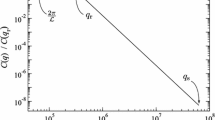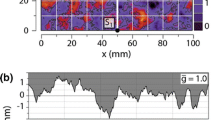Abstract
A numerical finite element contact model is developed to make use of the high precision surface topography data obtained at the nanoscale by atomic force microscopy or other imaging techniques while minimizing computational complexity. The model uses degrees of freedom that are normal to the surface, and uses the Boussinesq solution to relate the normal load to the long-range surface displacement response. The model for contact between two rough surfaces is developed in a step-by-step manner, taking into account the far-field effects of the loads developed at asperities that have come to contact in previous steps. Method accuracy is verified by comparison to simple test cases with well-defined analytical solutions. Agreement was found to be within 1 % for a wide range of practical loads for the high precision models. Applicability of extrapolation from lower precision models is presented. The real contact area estimates for micrometer-size tribology test machine surfaces are calculated and convergence behavior with mesh refinement is investigated.





















Similar content being viewed by others
References
Greenwood, J.A., Williamson, J.B.P.: Contact of nominally flat surfaces. Proc. Roy. Soc. Lond. A 295, 300–319 (1966)
McCool, J.I.: Comparison of models for the contact of rough surfaces. Wear 107, 37–60 (1986)
Yan, W., Komvopoulos, K.: Contact analysis of elastic–plastic fractal surfaces. J. Appl. Phys. 84, 3617–3624 (1998)
Majumdar, A., Bhushan, B.: Fractal model of elastic–plastic contact between rough surfaces. ASME J. Tribol. 113, 1–11 (1991)
Hyun, S., Pei, L., Molinari, J.F., Robbins, M.O.: Finite-element analysis of contact between elastic self-affine surfaces. Phys. Rev. E 70, 26117 (2004)
Persson, B.N.J., Bucher, F., Chiaia, B.: Elastic contact between randomly rough surfaces: comparison of theory with numerical results. Phys. Rev. B 65, 184106 (2002)
Polonsky, I.A., Keer, L.M.: A numerical method for solving rough contact problems based on the multi-level multi-summation and conjugate gradient techniques. Wear 231, 206–219 (1999)
Persson, B.N.J., Albohr, O., Tartaglino, U., Volokitin, A.I., Tosatti, E.: On the nature of surface roughness with application to contact mechanics, sealing, rubber friction and adhesion. J. Phys. Condens. Matter 17, 1–62 (2005)
Boussinesq, J.: Application des potentiels à l’étude de l’équilibre et du mouvement des solides élastiques (Application of potentials to the study of equilibrium and motion of elastic solids.). Gauthier Villars, Paris (1885)
Love, A.E.H.: The stress produced in a semi-infinite solid by pressure on part of the boundary. Proc. Roy. Soc. Lond. A 228, 377–420 (1929)
Webster, M.N., Sayles, R.S.: A numerical model for the elastic frictionless contact of real rough surfaces. ASME J. Tribol. 108, 314–320 (1986)
Poon, C.Y., Sayles, R.S.: Numerical contact model of a smooth ball on an anisotropic rough surface. ASME J. Tribol. 116, 194–201 (1994)
Ren, N., Lee, S.C.: Contact simulation of three-dimensional rough surfaces using moving grid method. ASME J. Tribol. 115, 597–601 (1993)
Liu, G., Wang, Q., Liu, S.: A three-dimensional thermal-mechanical asperity contact model for two nominally flat surfaces in contact. ASME J. Tribol. 123, 595–602 (2001)
Dickrell, D.J., Dugger, M.T., Hamilton, M.A., Sawyer, W.G.: Direct contact-area computation for MEMS using real topographic surface data. J. Microelectromech. Syst. 16, 1263–1268 (2007)
Delrio, F.W., De Boer, M.P., Knapp, J.A., Reedy, E.D., Clews, P.J., Dunn, M.L.: The role of van der Waals forces in adhesion of micromachined surfaces. Nat. Mater. 4, 629–634 (2005)
Cook, R.D., Malkus, D.S., Plesha, M.E., Witt, R.J.: Concepts and Applications of Finite Elements Analysis, 4th edn. Wiley, New York (2001)
Plesha, M.E., Cook, R.D., Malkus, D.S.: FEMCOD—Program Description and User Guide. University of Wisconsin-Madison, Madison (1988)
Young, W.C.: Roark’s Formulas for Stress & Strain, 6th edn. McGraw-Hill, New York (1989)
Borodachev, N.M.: Impression of a punch with a flat square base into an elastic half-space. Int. Appl. Mech. 35, 989–994 (1999)
De Boer, M.P., Luck, D.L., Ashurst, W.R., Maboudian, R., Corwin, A.D., Walraven, J.A., Redmond, J.M.: High-performance surface-micromachined inchworm actuator. J. Microelectromech. Syst. 13, 63–74 (2004)
Zhuravlev, V.A.: On question of theoretical justification of the Amontons–Coulomb law for friction of unlubricated surfaces. Zh. Tekh. Fiz. 10, 1447–1452 (1940)
Acknowledgments
We acknowledge Graham Wabiszewksi (University of Pennsylvania) for the MEMS surface images, the Microelectronics Development Laboratory at Sandia National Laboratories for the samples, Matthew A. Hamilton (Exactech, Inc), and W. Gregory Sawyer (University of Florida) for useful discussions. This work was partially supported by the National Science Foundation, grant CMMI 1200019, and by the US Department of Energy, BES-Materials Sciences, under Contract DE-FG02-02ER46016.
Author information
Authors and Affiliations
Corresponding author
Rights and permissions
About this article
Cite this article
Bora, C.K., Plesha, M.E. & Carpick, R.W. A Numerical Contact Model Based on Real Surface Topography. Tribol Lett 50, 331–347 (2013). https://doi.org/10.1007/s11249-013-0128-8
Received:
Accepted:
Published:
Issue Date:
DOI: https://doi.org/10.1007/s11249-013-0128-8




